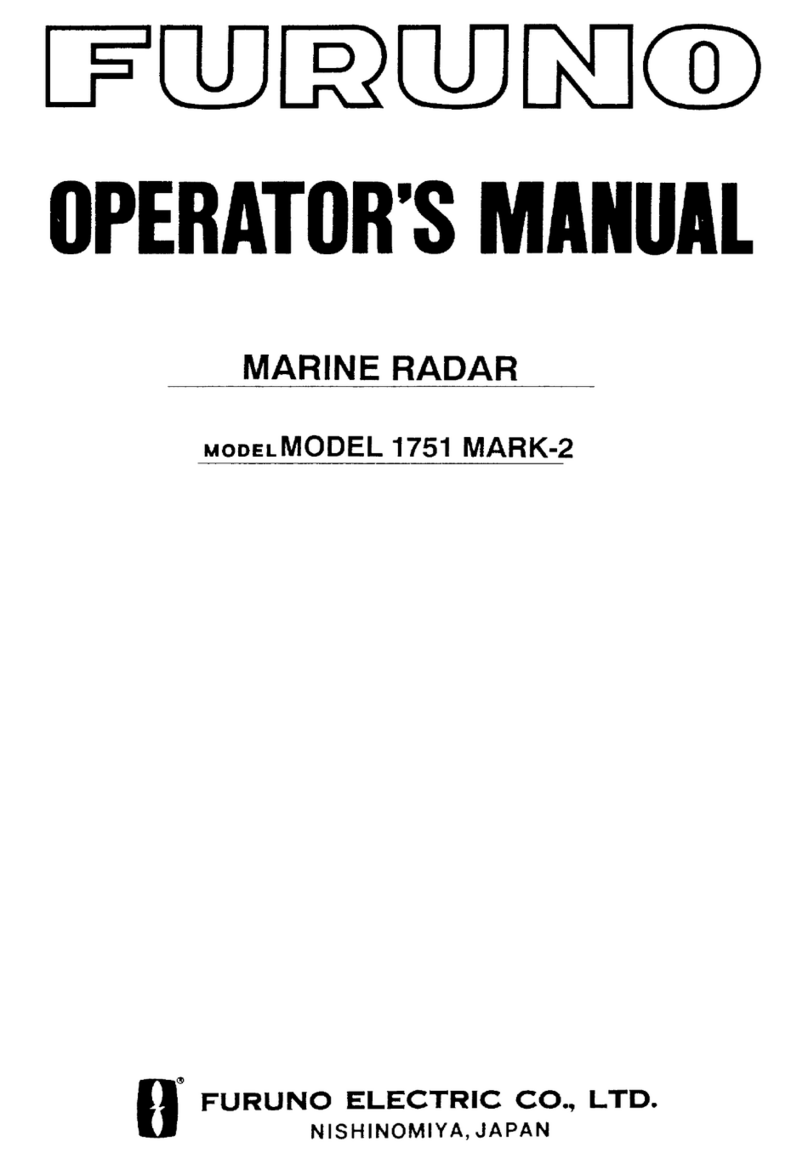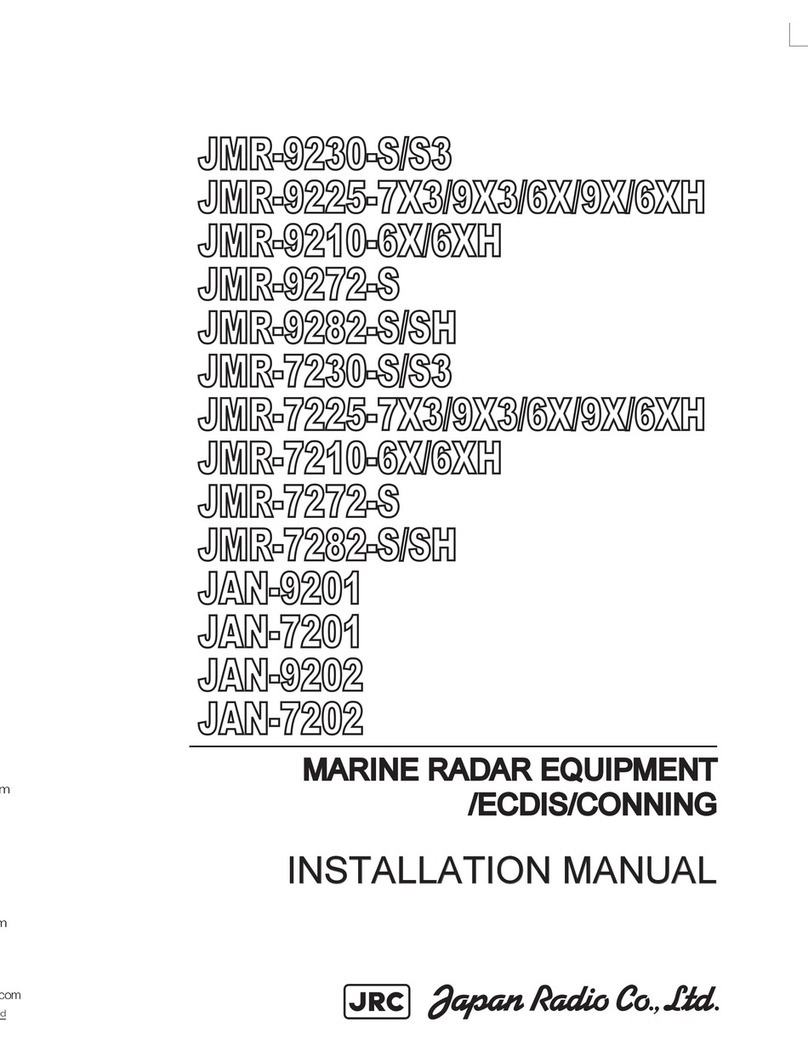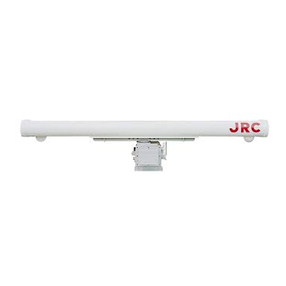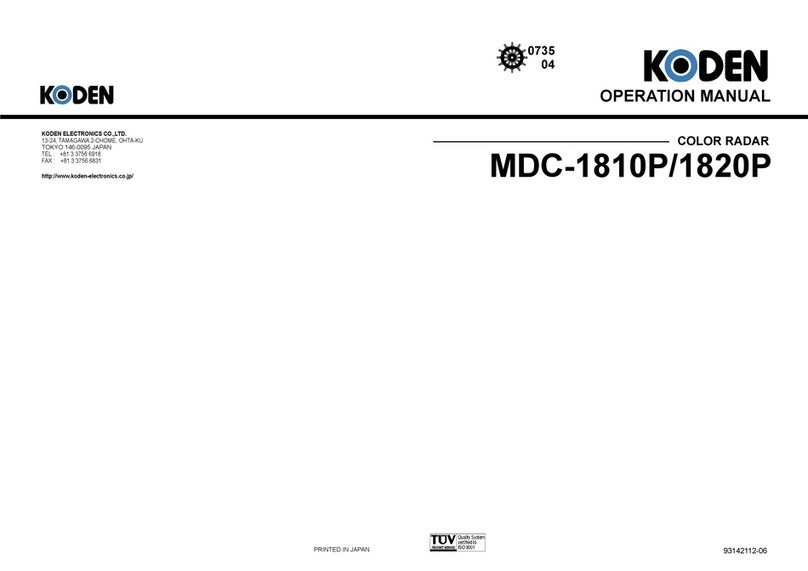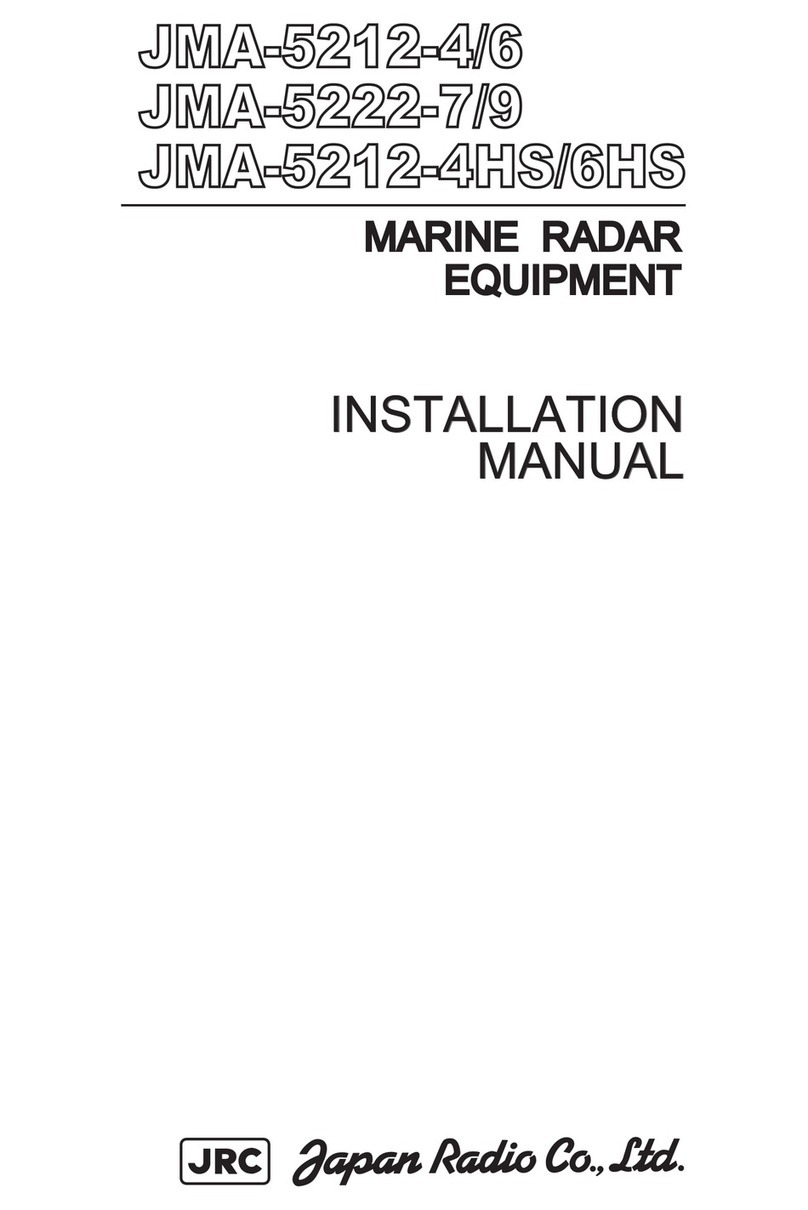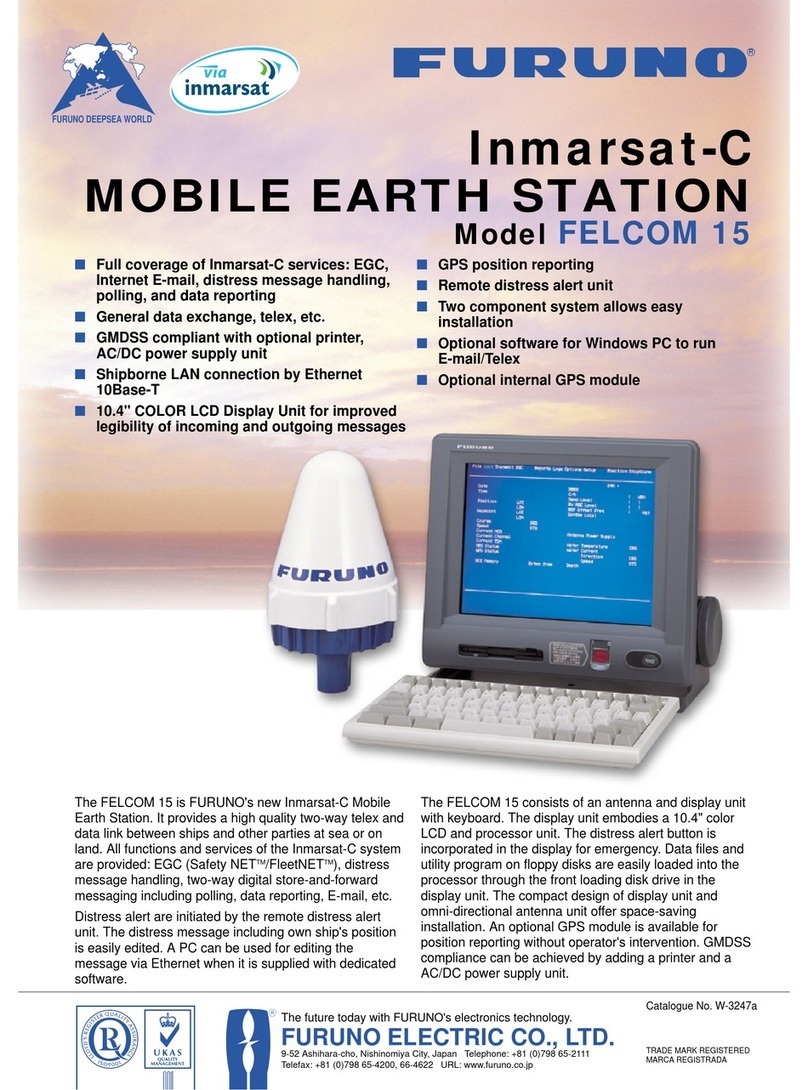Thrane&Thrane TT-3086A Sailor Fleet55 User manual

Thrane & Thrane A/S
TT-3086A Sailor Fleet55
TT-3084A Sailor Fleet77
Installation Manual
Document number: TT98-116875-E
Release date: March 15, 2007

Information in this document is subject to change without notice and does not represent
a commitment on the part of Thrane & Thrane A/S. It is recommended that the latest
version of the manual is downloaded from the Thrane Extra net or requested from the
distributor.
Copyright
© 2007 Thrane & Thrane A/S. All rights reserved. Printed in Denmark.
Trademark Acknowledgements
•Inmarsat is a registered trademark of the International Maritime Satellite
Organisation (IMSO) and is licensed by IMSO to Inmarsat Limited and Inmarsat
Ventures plc.
• Inmarsat’s product names are either trademarks or registered trademarks of
Inmarsat.
• Other product and company names mentioned in this manual may be trademarks or
trade names of their respective owners.
Company Addresses
www.thrane.com
Denmark Denmark
Thrane & Thrane A/S
Lundtoftegårdsvej 93 D
DK-2800 Kgs. Lyngby
Denmark
T: +45 39 55 88 00
F: +45 39 55 88 88
Thrane & Thrane Aalborg A/S
Porsvej 2
DK-9200 Aalborg SV
Denmark
T: +45 39 55 88 00
F: +45 96 34 61 01
USA China
Thrane & Thrane, Inc.
509 Viking Drive, Suites K, L and M
Virginia Beach, VA 23452
USA
T: +1 (757) 747-2341
F: +1 (757) 463-9581
Thrane & Thrane Shanghai
Representative Office
28J Pufa Tower
588 Pudong Rd(S), Pu Dong
200120 Shanghai
P. R. China
T: +86 21 68 87 87 80
F: +86 21 68 87 71 12

iii
Safety and Warranty 1
General
All cables for the Fleet55/77 system are shielded and should not be affected
by magnetic fields. However, if possible do not run cables parallel to AC
wiring – failing to do so might cause the equipment to be faulty or working
properly.
Service
User access to the interior of the BDU unit is prohibited. Service may only be
performed by a technician authorized by Thrane & Thrane A/S - failing to do
so will void the warranty. Access to the interior of the ADU is allowed, but
only for replacement of certain modules - as described in this manual.
General service may only be performed by a technician authorized by Thrane
& Thrane A/S - failing to do so may void the warranty.
Radar safety distance
Do not move the ADU closer to radars than the minimum safety distance
specified in this manual - this will possibly damage the ADU eventually.
Equipment must be installed with a minimum safe distance to magnetic
steering compass of at least 1.25 m. Personal safe distance is 4 m from the
F77 ADU and 2 m from the F55 ADU while it is transmitting.
Grounding, cables and connections
The BDU unit shall be connected to the ground of the ship via the Antenna
Pigtail Cable and the Grounding Kit (Accessories). Further, the BDU must be
grounded at its grounding stud.
The ADU shall be grounded to the ship via one or more of its mounting bolts.
The shielded cables must generally be grounded in both ends, except for the
cable between BDU and Cradle, which shall not be grounded in the Cradle
end.

iv
Connections of all types of equipment must be done while the unit is
switched off. For further grounding information read Appendix G Grounding
and RF protection on page 105.
Do not extend the cables beyond those specified for the equipment – except
from the cable between the BDU and ADU. The cable between the BDU and
ADU can be extended if it complies with the specified data concerning cable
losses etc.
Power supply
Operation voltage is 24 V DC. Note that long-term operation below 24 V DC
should be avoided.
It is recommended that the voltage is provided by the ship hot 24 V DC power
bus.
Be aware of high start-up peak current. 16 A@24 V, 15 ms.
Maximum operational peak power requirement for F77/F55 is 240/200 W
and maximum average power consumption is 180/150 W.
If a 24 V DC power bus is not available, an external 115/230 VAC to 24 V DC
power supply can be used.
Equipment ventilation
To ensure adequate cooling of the BDU a 5 cm unobstructed space must be
maintained around all sides of the unit (except the bottom side).
BDU ambient temperature range: -15°to +55°C.
Failure to comply with the rules listed above will void the warranty!

v
Table of Contents
Chapter 1 System Units
1.1 Introduction ............................................................... 1
1.2 Below Deck Unit – BDU .............................................. 1
1.3 Display Handset .........................................................2
1.4 Distress Cradle ...........................................................2
1.5 Passive Cradle ...........................................................2
1.6 Above Deck Unit – ADU ..............................................2
Chapter 2 GMDSS Installations
2.1 Requirements ............................................................3
2.2 Distress call initiation ................................................3
2.3 Maritime Safety Information ......................................3
2.4 Power Supply .............................................................4
Chapter 3 Placing the Antenna
3.1 Obstructions ..............................................................7
3.2 Radiation Hazard .......................................................8
3.3 Interference ...............................................................9
3.4 Antenna Mast Design ................................................14
Chapter 4 Installing the ADU
4.1 Unpacking ................................................................19
4.2 Preparation ...............................................................19
4.3 Grounding ................................................................19
4.4 ADU cables ..............................................................20

Table of Contents
vi
4.5 Mounting .................................................................22
4.6 Important notes .......................................................22
Chapter 5 Installing the BDU
5.1 Where to place the BDU ..........................................23
5.2 Grounding the BDU ..................................................24
Chapter 6 F77 Distress Cradle
6.1 Introduction .............................................................27
6.2 Distress Cradle Assembly .........................................28
6.3 Assembly - Default ...................................................28
6.4 Assembly – Alternative ............................................. 31
Chapter 7 F55 Passive Cradle
7.1 Introduction .............................................................33
7.2 Passive Cradle Assembly ..........................................34
Chapter 8 Connecting Power
8.1 Power cable selection ..............................................37
8.2 Power supply specification ...................................... 41
Chapter 9 Setting Up the System
9.1 Powering Up the System ..........................................43
9.2 Powering Down the System ......................................44
9.3 Service User Menu ...................................................44
Chapter 10 Hardware Interfaces
10.1 Overview ..................................................................53

Table of Contents
vii
10.2 Analogue 2-wire Interface .......................................54
10.3 Cradle/Handset Interface .........................................55
10.4 ISDN Interface .........................................................56
10.5 USB Interface ...........................................................57
10.6 LAN Interface ...........................................................58
10.7 RS-232 Interface ......................................................59
10.8 NMEA 0183/2000 Interface .......................................60
10.9 Discrete I/O interface ................................................61
Chapter 11 Service and Repair
11.1 Introduction .............................................................63
11.2 Modules .................................................................63
11.3 Power Supply Module (PSM) ....................................65
11.4 High Power Amplifier (HPA) .....................................66
11.5 Antenna Control Unit (ACU) .....................................67
11.6 Sensor Unit (SU) ......................................................68
11.7 End Stop Switches (ESS) ..........................................69
Chapter 12 Troubleshooting
12.1 Error messages .........................................................71
12.2 Handset Com Error troubleshooting procedure ........75
Appendix A Part numbers
A.1 TT-3086A Sailor Fleet55 ........................................... 77
A.2 TT-3084A Sailor Fleet77 ........................................... 77
A.3 Sailor Fleet55/77 Antenna Cables ............................78

Table of Contents
viii
A.4 Sailor Fleet55/77 Accessories ...................................78
A.5 Optional Sailor Fleet55 Cradle Cables .......................79
A.6 Optional Sailor Fleet77 Cradle Cables .......................79
A.7 Optional Sailor Fleet55/77 Cradles & handsets .........79
A.8 Sailor Fleet55/77 Spare Part Units ........................... 80
A.9 Sailor Fleet55/77 ADU Spare Parts .......................... 80
Appendix B F55/77 ADU Technical Specifications
B.1 F55 Technical Specifications ..................................... 81
B.2 F77 Technical Specifications .....................................83
B.3 F55/F77 Environmental Specifications ......................84
B.4 F55 Outline Dimensions .......................................... 85
B.5 F77 Outline Dimensions ........................................... 86
B.6 Outline Dimensions, Flange .....................................87
Appendix C F55/77 BDU Technical Specifications
C.1 Technical specifications .......................................... 89
C.2 Outline dimensions ..................................................92
C.3 Measuring the Ship Source Impedance ....................93
Appendix D Distress Cradle Technical Specifications
D.1 Technical specifications ...........................................95
D.2 Outline Dimensions ..................................................97
Appendix E Passive Cradle Technical Specifications
E.1 Technical Specifications .......................................... 99
E.2 Outline Dimensions ................................................ 100

Table of Contents
ix
Appendix F Handset Technical Specifications
F.1 Technical Specifications ..........................................103
F.2 Outline Dimensions .................................................104
Appendix G Grounding and RF protection
G.1 Why is grounding required? ....................................105
G.2 General about marine DC system ...........................106
G.3 General about marine grounding ........................... 108
G.4 Grounding Recommendations ................................. 110
G.5 Alternative grounding for steel hulls ....................... 112
G.6 Alternative grounding for aluminum hulls .............. 114
G.7 Alternative grounding for fiberglass hulls ............... 116
G.8 Alternative grounding for timber hulls .................... 118
G.9 Separate Ground Cable ...........................................120
G.10 RF interference .......................................................125
G.11 Electrostatic Discharge ............................................126
Glossary ........................................................................................127
Index ........................................................................................ 131

Table of Contents
x

1
Chapter 1
1111
System Units 1
1.1 Introduction
The basic system consists of four units: The Below Deck Unit (BDU), The
Control Handset, The Cradle and The Above Deck Unit (ADU).
1.2 Below Deck Unit – BDU
The Below Deck Unit (BDU) – which contains the primary electronic parts – is
designed for wall or desktop installation. The BDU supplies 42 VDC to the ADU
through a single coaxial cable. The F55/F77 BDU power requirement is
240/200 W peak and 180/150 W average at 24 VDC. The power shall be
provided by the ship hot 24 VDC power bus, or by an external VAC to VDC
power supply (minimum 10A). Be aware of high start-up peak current.
16 A@24 V, 15 ms.

Chapter 1: System Units
2DisplayHandset
1.3 Display Handset
The Display Handset allows dialling and control of the BDU and the antenna.
1.4 Distress Cradle
The Distress Cradle, which holds the Display Handset, provides activation of
alert transmission. The distress cradle may only be used for F77.
1.5 Passive Cradle
The Passive Cradle, which holds the Display Handset, provides no activation of
alert transmission. The passive cradle may only be used for F55.
1.6 Above Deck Unit – ADU
The antenna (ADU) consists of a stabilized antenna with RF-unit and an
antenna control unit, with GPS (ACU). All communication between the ADU
and BDU goes through a single coaxial cable. The antenna unit is protected by
a fibre glass radome - access to the interior of the ADU is possible through a
hatch located at the lower part of the radome.

3
Chapter 2
2222
GMDSS Installations 2
2.1 Requirements
(Not applicable for Fleet55 installations).
The International Maritime Organization (IMO) has set out requirements on
how the Fleet77 should be integrated in a Global Maritime Distress and Safety
System (GMDSS) installation:
IMO Resolution MSC.130(75).
IMO Resolution A.888(21).
2.2 Distress call initiation
For the installation to comply with IMO Resolution (MSC.130/A.3.2), it will
need to include a distress cradle and handset fitted on the bridge, as well as in
the radio communications room if applicable, for the ability to initiate distress
calls.
2.3 Maritime Safety Information
The TT-3084A Sailor Fleet77 meets the voice requirements of IMO Resolution
A.888(21). To meet the GMDSS carriage requirements of SOLAS (Safety Of Life
At Sea) in respect of receipt of SafetyNET broadcasts carrying MSI (Maritime
Safety Information) and direct printing telegraphy, it is necessary to install a
combined INMARSAT C/EGC transceiver in addition to the INMARSAT F77
equipment.

Chapter 2: GMDSS Installations
4 Power Supply
2.4 Power Supply
For the installation to comply with IMO Resolution (MSC.130/A.5.1), a Fleet77
forming part of a GMDSS installation needs to be able to switch between two
power supplies, a main and a backup source, where during main power
source failure, the Backup source normally would be automatic switched in
and maintain the Fleet77 system fully operational.
A power source change-over unit is not incorporated in the Fleet77 equipment
and thus is needed externally.
In principle there are two ways in which the required power supply back up
can be obtained:
1. “Hot” connection to the ships emergency batteries.
In this case the Fleet system is connected “directly” to the batteries and
the associated charger, and the charger supplies the power required for
the Fleet system. This ensures true “no-break” power supply for the Fleet
system. It is of cause necessary that the charger is powerful enough to
supply the power for the Fleet system, plus other systems which might be
connected to the batteries, such that the batteries are not discharged.
Be aware of high start-up peak current. 16 A@24 V, 15 ms.
Maximum operational peak power requirement for F77/F55 is 240/200 W
and maximum average power consumption is 180/150 W.
2. “Cold” or “switch-over” connection to the ships emergency batteries.
In this case the Fleet system is normally supplied from the ships AC line
(115 or 230 V) through an AC to DC (24-28 V) power supply. In case of loss
of line voltage the Fleet system power input is, either manually or
automatically, transferred to the emergency batteries. In many cases the
AC/DC power supply includes battery input and a relay for automatic
battery switch-over.

Chapter 2: GMDSS Installations
Power Supply 5
2222
Any interruptions on power sources possibly from power supply switch-over,
must be cleared within 60 seconds, for the Fleet77 to enable automatic power-
up and re-initialization. Furthermore, if a power interruption can be kept
below 20 ms, it can be guaranteed that a call (e.g. a distress call) will not be
disconnected during this. As it could be critical to maintain a call during an
emergency situation, it is strongly recommended that the power back-up
installation is made such that switch-over takes less than 20 ms.
The AC/DC power supply TT-3680F provided by Thrane & Thrane A/S, is usable
for GMDSS installations, and is capable of automatic switch-over to battery
power in less than 20 ms.

Chapter 2: GMDSS Installations
6 Power Supply

7
Chapter 3
3333
Placing the Antenna 3
3.1 Obstructions
The antenna rotates 360° and down to –25° in pitch and roll to allow for
continuous pointing even during the worst sea states. Any obstructions within
this volume can cause signal degradation.
The amount of degradation depends on the size of the obstruction and the
distance from the antenna. As a rule of thumb any obstruction, which
subtends an angle of less than 3° at the antenna will have limited effect. The
table below gives a guideline for obstruction sizes, which will cause limited
degradation.
Distance of
Obstruction Size of Obstruction
3m 16cm
5m 26 cm
10 m 52 cm
20 m 104 cm

Chapter 3: Placing the Antenna
8 Radiation Hazard
3.2 Radiation Hazard
The F77 antenna radiates 32 dBW EIRP (including 20 dBi antenna gain). This
translates to a minimum safety distance of 4 m from the antenna while it is
transmitting. This is based on a radiation level of 0.8 mW/cm2. The F55
antenna has a safety distance of 2 m.
For higher radiation level, see the table below.
Radiation level F55 Distance F77 Distance
100 W/m20.6 m 1.1 m
25 W/m21.1 m 2.3 m
10 W/m22.0 m 3.6 m
MICROWAVE
NO PERSONNEL
based on 10W/m2
2 m (F55)
3.6 m (F77)
25°

Chapter 3: Placing the Antenna
Interference 9
3333
3.3 Interference
The ADU (antenna) must be mounted as far away as possible from the ship’s
radar and high power radio transmitters (including other Inmarsat based
systems), as these can compromise the ADU performance. RF emission from
radars might actually damage the ADU.
As the Fleet ADU itself is a quite powerful transmitter, this on the other hand is
also capable of disturbing other radio systems. Especially, other Inmarsat
systems and GPS receivers with poor frequency discrimination are vulnerable
to the radiation generated by the Fleet ADU.

Chapter 3: Placing the Antenna
10 Interference
3.3.1 Radar
It is difficult to give exact guidelines for minimum distance between a radar
and the ADU – as radar power, radiation pattern, frequency and pulse
length/shape varies widely from radar to radar. Further, the ADU will typically
be placed in the near field of the radar antenna and reflections from masts,
decks and other items present in the vicinity of the radar will be different from
ship to ship.
Despite the issues mentioned above, the guidelines below can be given:
Since a radar radiates a fan beam with a horizontal beam width of a few
degrees and a vertical beam width of up to +/- 15°, the worst interference can
be avoided by mounting the ADU at a different level – meaning that the ADU is
installed minimum 15° above or below the radar antenna. Due to near field
effects the benefit of this vertical separation could be reduced at short
distances (below approximately 10 m) between radar antenna and ADU.
Therefore it is recommended to ensure as much vertical separation as possible
when ever the ADU has to be placed close to a radar antenna.
This manual suits for next models
1
Table of contents
Other Thrane&Thrane Marine Radar manuals

